has 13+ years experience in web development, ecommerce, and internet marketing. He has been actively involved in the internet marketing efforts of more then 100 websites in some of the most competitive industries online. John comes up with truly off the wall ideas, and has pioneered some completely unique marketing methods and campaigns. John is active in every single aspect of the work we do: link sourcing, website analytics, conversion optimization, PPC management, CMS, CRM, database management, hosting solutions, site optimization, social media, local search, content marketing. He is our conductor and idea man, and has a reputation of being a brutally honest straight shooter. He has been in the trenches directly and understands what motivates a site owner. His driven personality works to the client's benefit as his passion fuels his desire for your success. His aggressive approach is motivating, his intuition for internet marketing is fine tuned, and his knack for link building is unparalleled. He has been published in books, numerous international trade magazines, featured in the Wall Street Journal, sat on boards of trade associations, and has been a spokesperson for Fortune 100 corporations including MSN, Microsoft, EBay and Amazon at several internet marketing industry events. John is addicted to Peets coffee, loves travel and golf, and is a workaholic except on Sunday during Steelers games.
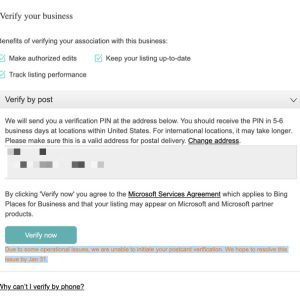
Microsoft’s Bing Places for Business has been broken for months, with no fix in sight. The verification page still displays the message: “Due to some operational issues, we are unable to initiate your postcard verification. We hope to resolve this issue by Jan 31.”
Originally, this deadline kept getting pushed further down the calendar. Now, they’ve simply stopped updating it—leaving businesses stuck, unable to verify their listings, and the message outdated by over a week.
Seriously, Microsoft—you’re a $3.5 trillion company, yet you can’t manage to fix a basic function that allows local businesses to appear on your map? Instead, you’re too busy pushing AI into every product while neglecting essential services. Maybe focus on making Bing Places actually work before expanding into the next big thing. This is beyond ridiculous.
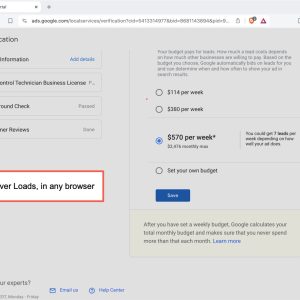
Google Local Services Ads have been quite a headache lately, due, to the challenges faced with updating budgets. Its been an experience dealing with these issues.
Google Local Services Ads (LSA) which could revolutionize businesses by providing a platform, for expansion and visibility enhancement has its share of challenges that seem unbelievable for a company valued at $ 2 trillion.
An unsettling encounter, for newcomers.
For beginners, in LSA (Local Sensory Augmentation) setting up your account might feel like a challenge at times! Creating an account could turn into a bit of a headache as you find yourself repeatedly filling out forms only to see them reset when you thought you were done with the data entry marathon! I’ve faced this issue myself on occasions while using web browsers. After struggling through tries with popular browsers like Chrome and Firefox I eventually found success, with the Brave browser.
Struggles, with Keeping Budgets Updated
Despite managing to tackle the obstacles the problems didn’t end there; it was a real challenge to update the budget section, on the LSA platform—it seemed almost impossible! No matter which browser I tried—whether Brave or others—the system kept spinning without making any updates; this persisted as an issue. Made the platform nearly unusable.
Seeking Betterment
It’s surprising that a company big and capable as Google would launch a product, with basic issues like this one here in Google Local Services Ads program – it holds great promise, for small businesses but seems pretty shaky in its current form.
Google must tackle these problems away because a product, with potential shouldn’t be held back by technical issues that make it barely usable. If Google can fix these glitches and make LSA more reliable it could really become an asset, for businesses.. For now users are stuck dealing with a service that doesn’t meet their expectations.

In the realm certain sectors are susceptible, to attracting comments that can spiral into a cycle of criticism; when a couple of negative reviews surface initially others tend to chime in highlighting minor flaws to amplify the negativity. Rival companies may also take advantage of this situation by posting reviews to sabotage other businesses within the same industry vertical.
We oversee the reputations of clients, at Web Moves and have a track record of effectively spotting and addressing untrue or deceptive reviews by reporting them diligently. A year back we encountered a company named Get Dandy that positioned itself as an expert, in eliminating reviews.Their sales presentation was impressive as they guaranteed outcomes. They showcased a software program created to uncover weaknesses in the terms and conditions of platforms such, as Google, Yelp and Facebook to support the deletion of negative reviews.
After the first meeting concluded I left feeling greatly impressed. Being someone experienced in creating tailor made software solutions I could see their system was solid and expertly crafted. Additionally they shared stories of achievements, with customers highlighting reductions in negative feedback. It left me feeling hopeful.
The Truth About Using Get Dandy’s Service.
The initial setup process went well. The software performed as anticipated at glance.It sifted through the feedback. Filed removal requests, in accordance, with platform regulations.During the 90 day period everything appeared to be heading in a direction.We were pleased to note that around 15 reviews were successfully removed despite the pace of progress.
After that? Nothing happened for months without any more reviews being taken down. Even though there were discussions and assurances that “the system is functioning ” no advancements were seen. The customer service provided consultations that appeared hopeful, at glance but turned out to be just a roundabout way of handling things.
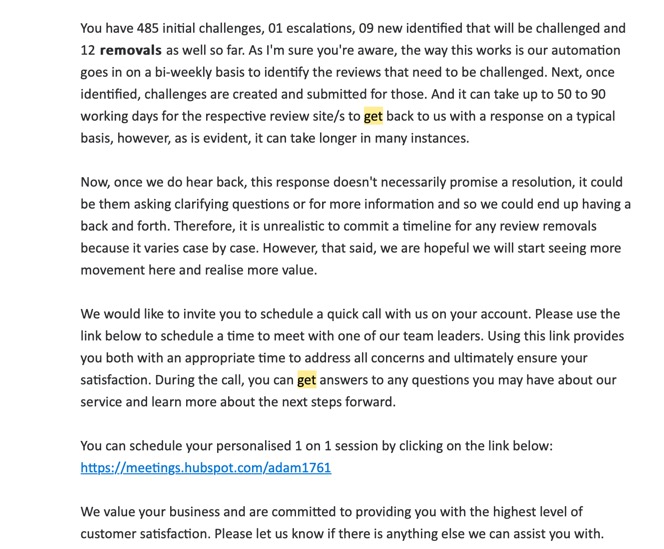
We began with an account containing 500 negative reviews. In the presentation they projected that, they estimated 50% or more of these would be removed. After 12 months, 500 negative reviews later, and $3,600 spent, the total number of reviews removed was…14. That’s a mere fraction of what was promised.

Over the four months I’ve been trying to find a solution. Requesting chargebacks and contacting the CEO via LinkedIn.. All I’ve gotten in return are threats of legal action, from them. Despite their software and impressive sales pitches Get Dandy has turned out to be nothing than a huge disappointment, in terms of both time and money spent.
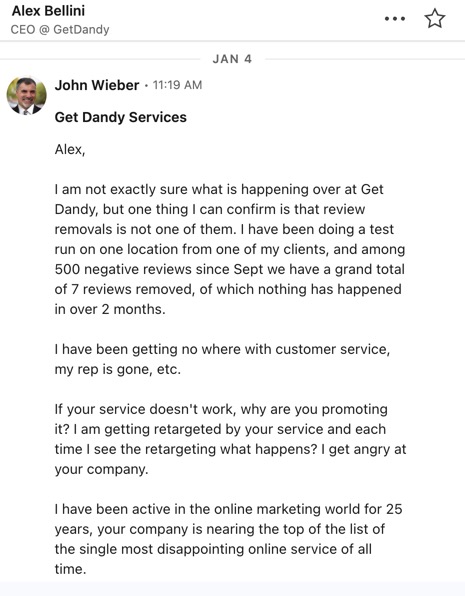
My advice is to steer clear of the stuff.
The technical prowess displayed in the software created Get Dandy is truly remarkable and serves as a sales asset; however despite the facade their actual service falls short of expectations.. The commitments made around reducing reviews often remain unmet leaving customers feeling unsatisfied.. Furthermore once a customer is committed, to their services the responsiveness of their customer support team diminishes substantially..
If you’re thinking about using Get Dandy services be cautious because even though they present themselves well the outcomes are not, up to par as expected Their current service offering is lacking and the fact that their CEO has been quiet, on LinkedIn says a lot. A word for the CEO of Get Dandy, Alex Belinni, if you had replied to my Linked In Message, this post never would of happened.

In our role, as a marketing firm handling accounts, through Angi Leads (a.k.a HomeAdvisor) platform we’ve noticed a troubling pattern that brings up significant doubts regarding the platforms reliability and validation procedures.
10 days ago is when things kicked off for us. We spotted something, in a Florida account with a batch of leads that raised our eyebrows. These three leads all went by the name “Brayan Wood”. Popped up within five minutes from totally different areas of coverage. Clearly something wasn’t right about it all we flagged them as fake. Promptly got in touch with Angi’s support team to report the situation and luckily received credit for the questionable leads. Initially brushing it off as either a lone scammer at work 0r someone trying to pull a fast, on us with the system.
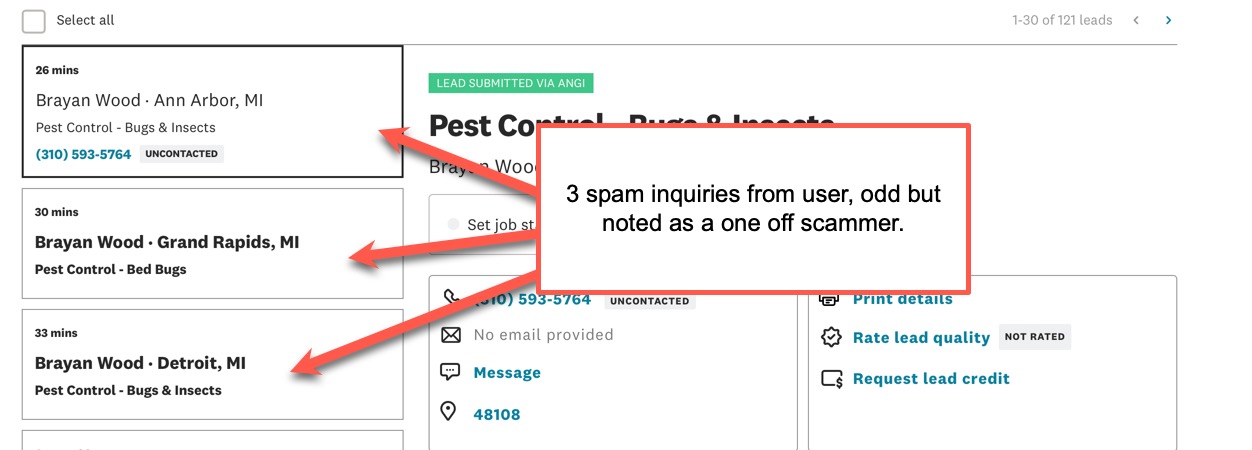
The situation became more concerning yesterday when we noticed a pattern, in a Michigan based account well. Three leads were received from “Brayan Wood,” each from service areas in succession. The resemblances, between the two situations were too noticeable to overlook indicating that this was not a coincidence but a planned effort to deceive Angi users.

Seeing the perspective.
Upon inspection three counterfeit leads may not appear significant; however when you take into account that each lead carries a price tag of $40 the expenses begin to accumulate quickly. In this scenario three fake leads translate to a loss of $120. If this fraudulent activity is happening across accounts. Even hundreds or thousands. The financial consequences become quite significant.
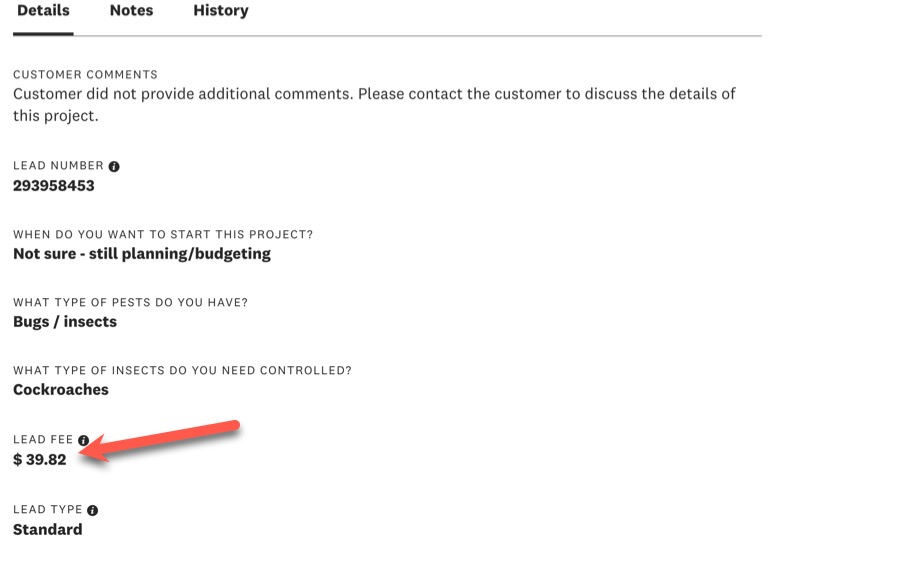
It is alarming to see activities happening on Angi Leads despite its resources and prominent position, in the lead generation sector.
Who could be responsible, for this?
The big question here is who is pulling the strings behind all of this? It’s not crystal clear, at the moment. One thing we can say for sure is that this isn’t just a problem popping up out of nowhere. Seeing this same pattern play out in two situations across different states makes it seem like theres a bigger plan, at work here. Like someone or some group is purposefully taking advantage of the system.
The name “Brayan Wood” may not hold significance independently; however if various companies are encountering this name in leads consistently it could help us pinpoint the source of this scam more accurately.
Why is this important, in the scheme of things?
For individuals who depend on lead generation platforms such, as Angi’s Leads for their businesses growth and sustainability the importance of receiving genuine and high quality leads cannot be overstated. Wasting money and valuable time pursuing leads is detrimental to a company’s bottom line and productivity. When fraudulent activities permeate Angi’s platform it not only erodes user trust but also raises concerns, about the integrity of their validation procedures.
What We’re Inquiring About
Has anyone else using Angi Leads encountered a situation, like this before? Have you received leads from “Brayan Wood”. Observed any trends in your accounts recently? This might be happening in industries or locations with types of services involved. If you have experienced something to this scenario mentioned above. Wish to share your insights or thoughts on it with us. Feel free to reach out! We’re keen to hear from you and learn more, about your experiences.
Our aim is to gather details in order to shed light on this matter and advocate for security and measures to prevent fraud, by Angies List representatives.
Wrapping Up Ideas
Scams have always been a presence, in the lead generation realm; however it is disconcerting to witness them infiltrate a platform like Angi. A company with substantial resources and revenue streams that should theoretically be more secure, against calculated fraud schemes. It’s crucial for us to delve further into this matter and urge businesses to remain watchful and alert.
If you’ve observed any resemblances or commonalities, in your experiences recently and wish to discuss about it with me; I’m here to collaborate with you on holding platforms responsible and verifying the value of leads we invest in.
You can email me at john@webmoves.net with any information you may have.
Thanks
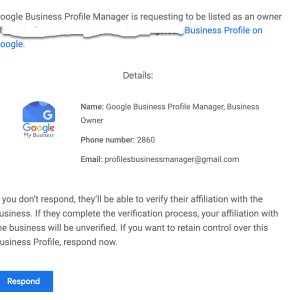
We’re seeing an alarming surge in attempts by spammers and bots trying to exploit Google’s Business Profile Manager. The common approach is to request ownership of your Google My Business (GMB) profile pages. The threat is real, and it’s widespread; we’re seeing a massive volume of these requests across all clients.
Here’s how it works: You receive an email request for ownership of your GMB page. The email may seem legitimate at first glance, but it’s a scheme. Once you accept the request, these unscrupulous actors can gain control of your business listing, which allows them to manipulate your business’s public-facing information, leading to a plethora of potential issues including misinformation, fraudulent reviews, or worse.
These emails can be cunningly crafted and persuasive. That’s why it’s absolutely crucial to be vigilant when dealing with ownership requests. An unexpected request should always raise a red flag.
Teamwork is the key to combating this threat. Good communication across all departments – be it management, IT, marketing, or staff – is vital. Make sure everyone is aware of this issue, and that they know what to do if they receive such a request.
Here are a few steps to prevent falling into this trap:
-Be skeptical of unsolicited ownership requests. Only grant ownership to trusted individuals who need it.
-Implement a protocol for dealing with GMB ownership requests.
-Regularly check the users list in your GMB dashboard to make sure all owners and managers are legitimate.
-In case of doubt, don’t hesitate to contact Google’s support team.
Security of your online assets should be a top priority. Please share this message to ensure we minimize the impact of these potential attacks.
Google Bard is a striking new addition to the world of search technologies, offering unprecedented opportunities for users to search and access content from diverse digital sources. With its revolutionary approach to search and access, Google Bard promises to revolutionize the way in which we find, access and consume content.
Through its cutting-edge technology and innovative search engine, Google Bard enables users to retrieve content and data from a wide range of digital sources – including websites, videos, audio, documents, and more. Furthermore, by leveraging powerful algorithmic techniques, Google Bard will allow users to access and refine search results in an entirely new way – delivering precise and precise search results.
The implications of this remarkable new search technology will be far-reaching; from cutting edge advancements in the field of data analysis and artificial intelligence, to the complete restructuring of how content and information is accessed and consumed – Google Bard has the potential to disrupt the entire search industry.
Google Bard has revolutionized how and what we search on the internet. It broadened the context of searching, being the first to utilize artificial intelligence to explore the web’s deepest depths.
Its impact is far beyond what it was once thought to be capable of; it outperforms traditional search engine results. Unveiling Google Bard is the focus of this article, and the pieces of what it encompasses and the impact it has had on search culture will be discussed.
From introducing machine learning algorithms to automated web content crawling, we have a clearer understanding of the now-ubiquitous search engine.
Google Bard is a search engine that makes use of natural language processing (NLP) for search queries. It allows users to search for information by asking a question in plain language, as opposed to standard keyword-based search queries.
Google Bard attempts to understand the intent behind the question, and then returns a list of results that provide an answer. Not only does it recognize individual words or phrases from a query, but it also understands the underlying relationship between those words or phrases in order to better understand the user’s intended query.
Through this approach, Google Bard tries to provide an improved search experience for casual users.
Google Bard is a free and open-source text editor for switching between programming languages. It allows users to rapidly switch between languages and make syntax corrections, including a comprehensive set of its own syntax rules, through its built-in auto-complete feature.
It is highly recommended for developers and allows users to code quickly and efficiently. The intuitive drag-and-drop editing feature makes it easy to build complex applications and explore new ways to code.
It is designed to work well with both source code and non-programming languages, allowing users to move quickly between the two. In addition, it runs on multiple platforms, making it an ideal choice for developers who need to develop for different systems.
Google Brain is a large-scale artificial intelligence research project using deep learning techniques developed by Google. It brings together researchers and engineers from various Google products to work on deep learning applications such as computer vision, language processing, and knowledge extraction.
The researchers utilize neural networks, a powerful data modeling tool based on the workings of the human brain, to teach computers to recognize patterns and solve problems. Through research, the team works to improve the quality of machine intelligence and capabilities of natural language processing.
Google Brain is used to teach computers to recognize objects in images, understand and respond to text-based conversations, and aid in research and development of self-learning machine learning models.
Google Bard is an innovative new tool that allows users to quickly search for facts, images, videos, and documents through the web. Utilizing the latest in natural-language processing, Google Bard enables users to accurately direct their search queries to the most relevant sources, thereby saving valuable time.
Additionally, Google Bard incorporates a “reverse search” feature – using only an image or photo as input – allowing for a comprehensive search of the web for similar images. In addition, Google Bard is extremely easy to use; it does not require any sophisticated understanding of computer programing or prior knowledge of the web.
Google Bard’s efficient, user-friendly interface, combined with the remarkable power of its search capabilities, make it an invaluable resource for customers seeking quick access to the most accurate information.
Google Bard is a new language translation app that allows users to communicate with a foreign language speaker through a microphone and patent-pending speech recognition technology. While this exciting new technology has numerous advantages, there are some potential challenges that can arise when using it.
One significant challenge is accuracy. There is still a chance for unrecognized words or misheard words due to sound quality or background noise.
Additionally, there is the potential for cultural misunderstandings when using translated sentences as native speakers may use language differently from region to region. Even though the app has been tested extensively, it is possible to encounter technical issues such as poor communication due to poor internet connections.
Lastly, there is an inherent limitation on the app due to the fact that not all foreign languages are available, posing a problem for those who need need to translate rarer languages. All in all, while Google Bard can be helpful in certain situations, potential users should be aware of some of the obstacles they may face.
Google Bard is a powerful tool for assessing the impact of search engine optimization. It helps marketers to better understand how their SEO efforts impact the visibility of their website by tracking the number of clicks, impressions and conversions generated by each keyword.
It provides insights into keyword performance across multiple channels including organic search and paid search. Additionally, it can help identify opportunities for optimization, identify patterns in user behavior, and inform strategic decisions about future changes.
By understanding the impact of SEO, businesses can make better decisions about how to increase their visibility and drive better results from their website.
Google Bard is a new technology that promises to revolutionize the way that people search for information online. It uses enhanced artificial intelligence (AI) to examine how people search for information and delivers more accurate search results.
Google Bard will be able to anticipate user searches, learn more about a particular query, and deliver more contextual information. Additionally, Google Bard will use neural networks to help better understand what the user is searching for even if the query is incomplete or unclear.
Google Bard is expected to provide more efficient and faster search results with fewer errors and more precise answers than in the past. Finally, Google Bard understands that different users have different needs and preferences, allowing for more personalized search results tailored to the individual.
As it continues to evolve, Google Bard will surely change the way that people search online.
Web Moves, a Internet Strategists, can help you understand how Google Bard will affect your search engine results. Google Bard is a new service which allows webmasters and content creators to quickly analyze and diagnose web performance.
It can help content creators to optimize their pages for better performance, which in turn can yield higher search engine rankings. With it, they can also track page loading times, troubleshoot slowdowns and ensure none of their structural coding has a significant impact on their website ranking in search engine results.
Ultimately, Google Bard can help content creators better manage their online presence, resulting in improved SEO and better overall search engine results.

Google Bard is a new ranking algorithm from Google that leverages natural language processing to better understand the intent behind web searchers and improve search results. Google is constantly striving to make its search engine as accurate and useful as possible, and Bard is designed to do just that.
With Bard, web searchers can rest assured that their search results will be more relevant to their query and ultimately provide them with the answers they are looking for. The launch of Google Bard is an exciting development that will help people make the most of their online searches.
The age of integrated technology is here! Microsoft has recently announced that their BING search engine is now integrating ChatGPT, the conversational AI. This means that you will be able to get more conversational answers for any queries you have regarding a topic of interest.
With ChatGPT, users can have an actual dialogue with the AI, allowing them to quickly access in-depth explanations, rather than the few points of information a simple search URL can provide. BING’s integration of ChatGPT will raise the bar in terms of AI, bringing optimized search conversations and results all in one place.
Introducing AI-Powered Conversational Search with BING and ChatGPT: introducing a revolutionary new technology merging two powerful AI concepts, allowing users to experience a natural search process using natural language. Harnessing the power of Bing search and ChatGPT, users will be able to ask complex questions and receive natural and comprehensive answers, not just results.
This remarkable AI driven search will allow users to find the most relevant answers to their questions in a way that feels almost conversational. Combining the powerful search capabilities of BING with the advanced natural language understanding of ChatGPT will be a game changer in how we search the internet.
AI-Powered Conversational Search provides users with a conversational search experience that goes beyond the predictive capabilities of traditional search. Through natural language processing and machine learning, AI-Powered Conversational Search can identify user intent in search queries, anticipate and suggest related topics, and deliver relevant, personalized search results in context.
With the advantages of natural language search and smarter results, AI-Powered Conversational Search helps to reduce cognitive load, simplify complex searches and provide users with the most relevant information in fewer clicks, making search more effective, efficient and enjoyable.
AI-powered conversational search provides many benefits to businesses who use it to better understand their customers. It allows businesses to provide customers with more personalized results that are tailored to their exact needs, quickly returning accurate answers to their queries no matter how they are phrased.
With AI-powered conversational search, businesses can quickly and easily access detailed insights into customer behaviors and the effectiveness of their product. This can help businesses to make better decisions when it comes to product development, marketing, and customer engagement. Furthermore, conversational search can provide businesses with real-time feedback on customer service responses, enabling them to promptly address customer issues and ensure satisfaction.
AI-powered conversational search allows businesses to both anticipate customer needs and transact with them more effectively, creating a seamless and valuable customer experience.
Bing, an artificially intelligent conversational agent powered by natural language understanding and advanced deep learning technologies, has developed ChatGPT, a new end-to-end open-source dialogue system. ChatGPT combines state-of-the-art capabilities in natural language understanding, natural language generation, and deep reinforcement learning.
It enables Bing to understand complex conversations and respond to queries in a more natural, conversational manner. ChatGPT provides a more personalized and engaging chatbot experience by delivering tailored, context-relevant responses drawn from previous conversations.
In addition, it can generate responses based on a user’s preferences and trends, making the conversation even more interactive and engaging. Bing’s ChatGPT will be available soon as an open-source dialogue system on GitHub, allowing developers to customize it to their own needs.
BING and ChatGPT offer numerous advantages for natural language processing. BING, an AI-driven search engine, helps simplify data-heavy tasks by automatically finding relevant content and displaying results in an organized manner.
Additionally, it helps save time by quickly finding questions to answer and extensive resources through its advanced search feature. ChatGPT, a conversational AI, allows businesses to provide automated customer service and communication.
Furthermore, it helps in increasing both customer satisfaction and engagement by automatically answering questions with natural language understanding and human-like responses. By using these two solutions together, businesses are able to drastically improve their efficiency while providing better customer service.
In today’s world, it has never been easier to get started with BING and ChatGPT. Utilizing the latest Natural Language Processing (NLP) technology, getting started with BING and ChatGPT can be as simple as downloading the pre-trained models and plugging them into a text-capable chatbot.
Once the models are downloaded, developers can customize BING and ChatGPT models to fit their specific use cases. By utilizing these models, developers can have better control over their chatbot conversations, making them more intuitive and engaging for users.
With these features, getting started with BING and ChatGPT is a great first step in creating an AI-powered chatbot.
In conclusion, the combination of AI-powered conversational search, Bing, and ChatGPT could have a significant impact on the world’s search experience. ChatGPT provides an important way for users to create search queries with natural language questions or commands and get results in record time.
Meanwhile, Bing is selecting and ranking the results based on its own AI-powered algorithm. All of this adds up to quicker and smarter search results that optimize users’ time and effort.
Ultimately, AI-powered conversational search has the potential to revolutionize how users search the web and make it easier than ever to find the information they need.
Web Moves is an Internet Strategist specializing in using up-to-the-minute technology to create innovative, effective solutions for clients. By leveraging BING’s integration of ChatGPT into search, our team of experts can maximize the reach of your brand, foster more authentic connections with customers, and gain valuable insights into customer preferences.
Our state-of-the-art expertise and strong market awareness allow us to assess quickly and create effective strategies tailored to your business goals. We provide customized campaigns that drive results and help grow your business in a w … ay that’s both efficient and sustainable.
Let us leverage the new opportunities that ChatGPT provides to create an enhanced digital presence and capitalize on all the resources at your disposal!

The advances in machine learning and natural language processing have enabled BING to take their search engine to the next level with ChatGPT. In conclusion, BING’s decision to deploy ChatGPT in search is another step towards an easier to use, assistant-driven approach to searching the internet.
We look forward to seeing the full impact of this integration on how we interact with the internet and get the answers we need faster.
Are you looking for ways to maximize your Magento 2 business? You’re in luck! In this post, we’ll discuss 10 essential shortcuts to help Magento 2 businesses optimize efficiency and cost. By taking advantage of these tips and tricks, you can leverage the success of your eCommerce business and improve your bottom line.
Let’s get started!
This article is all about helping to make your Magento 2 business more efficient! We will dive into the 10 best shortcuts to help you save time and maximize the potential of your business. These tips are easy to follow and include a range of tactics from better organization and automation to streamlining processes and daily tasks.
From mincing your routine operations to optimizing navigation and user interfaces, you’ll get everything you need to increase your business’s efficiency. Ready to learn more? Let’s get started and make Magento 2 business more efficient with these 10 shortcuts!
Table of Contents
Magento 2 Efficiency is a comprehensive suite of tools that allows businesses of all sizes to enhance their e-commerce operations. It provides developers with a comprehensive and powerful platform to easily manipulate dynamic data flows and integration of a wide array of specialized modules.
This platform has been optimized to maximize efficiency and performance, resulting in impressive loading speeds, scalability and minimal downtime. Its easy-to-access APIs makes it easier to integrate with third-party systems and services; while robust architecture and improved frontend experiences provide a host of powerful capabilities and efficiencies.
With Magento 2, businesses can take advantage of advanced features such as automation and customization, unified ways to access, store, manage and search data and improved security features. There’s no doubt that this platform provides the ideal foundation for businesses looking to grow their capabilities and drive efficiency, scalability and success.
Magento 2 is an open source platform designed for optimizing online stores. It provides enhanced speed, scalability and exceptional flexibility to developers.
The system enables merchants to increase efficiency thanks to its improved load times, advanced search capabilities, and streamlined checkout process. Magento 2 also offers great customer experience through flexible layouts, smooth navigation, and the ability to personalize product pages.
These features ultimately help businesses drive sales, increase customer loyalty and keep up with the competition. Additionally, the improved efficiency of Magento 2 ensures merchants can spend less time managing the backend so they can focus on strategies that will propel their business forward.
Product data management (PDM) is a vital business process for tracking product development and successfully delivering on mission-critical initiatives. Automating product data management can help you stay better organized, providing increased accuracy and insights into your product development cycle.
The automation of the PDM process offers the potential for greater speed and reliability by eliminating the manual labor required to manage products from concept to delivery. Automation also allows for improved access control and item administrating which is critical for analyzing data points and delivering on market-specific needs.
With an automated process, you can still create detailed reports and simulations to better inform your decision-making process, allowing you to increase your productivity as well as the quality of your product.
Customer support is essential for business success, yet often tedious and time consuming. Streamlining customer support is key for businesses to improve efficiency and drive higher customer satisfaction.
By implementing AI chatbots, companies can create an automated, personalized customer experience faster, more reliably, and more cost efficiently than ever before. AI chatbots can answer simple questions, direct customers to the best solutions to their needs, and, when AI can’t help, easily direct customers to a live agent for assistance – eliminating tedious escalations and transfers, resulting in more efficient, effective service.
In addition, AI-driven chatbots can be customized with an abundance of intents and dialogue, empowering businesses to better understand their customers and create preferred customer experiences that are both reliable and timely.
Magento 2 caching can provide a significant performance boost for any website. Utilizing Magento 2’s numerous caching mechanisms, websites can anticipate decreased page loading times, improved customer experience, and faster loading of content.
In addition, caching can also improve website functionality, as well as reduce server load, allowing for greater scalability. Beyond standard caching techniques, Magento 2 offers a variety of advanced techniques to ensure fast loading times and can integrate with a range of caching solutions, offering the flexibility to choose the most appropriate caching solution to meet website needs.
Furthermore, Magento 2 can extend its caching capabilities by utilizing content delivery networks (CDNs). These CDNs can deliver cached content directly to a requesting browser while reducing the load on the server, likely leading to further reductions in loading times and improved experiences for website visitors.
Cloud computing has revolutionized the way data analytics can be utilized. With cloud computing, data is stored remotely, allowing users to access the data from any device with an internet connection from any location.
This means increased flexibility, with the ability to quickly analyze and respond to trends in the vast amounts of data available. Cloud computing also helps keep storage costs to a minimum and increases scalability for data analytics.
Additionally, the technology powering cloud computing is constantly being improved and updated, thereby offering a more robust platform to rely on for data analytics. This, in combination with 24/7 availability and customer service, makes cloud computing an excellent choice for data analytics.
Simplifying payment processes with Magento 2 Gateways can be an effective solution for online stores. Magento 2 Gateways provide secure, reliable and efficient payment processing that is PCI and DSS compliant.
Not only does it ensure a safe and secure online shopping experience, but it also helps streamline checkout process and reduce errors. The user-friendly interface makes it significantly easier to process customer payments quickly with less effort involved.
Magento 2 Gateways can be customised to fit into any workflow and support a variety of payment methods including credit cards, PayPal, Apple Pay, Amazon Pay and more. This flexibility and simplicity is guaranteed to save time and resources for any online business.
Advertizing and promotion are both important elements in any business or organization. To best maximize success, these two marketing techniques should be integrated throughout all advertising, promotions, and outreach activities in order to provide customers with clear, consistent messages about a particular brand, product, or service.
An advertizing and promotion integration strategy should be effective in both good times and bad, allowing businesses and organizations to capitalize on positive brand associations and mitigate the effects of negative news. When done properly, integration of advertising and promotion activities can result in increased market share, improved customer loyalty, and cost-efficiencies gained through media and vendor negotiations.
Enhanced security is essential for any Magento 2 store. Magento offers regular security-only patch releases, consolidating functional and security fixes from each previous version into a single release.
After evaluating the potential network, database, and application server risks, users can install these patches. Security patches protect against known vulnerabilities and help mitigate physical, social engineering, technical, or policy-oriented threats while helping to maintain compliance.
To further strengthen security, new security patches are released regularly and are immediately ready to be installed. Patching Magento 2 is an important step to keep customer and business data safe and secure.
In conclusion, it is clear that there is a great deal to consider when approaching a problem. Careful analysis of the issue, factoring in the available resources and potential outcomes, can help to ensure a successful resolution.
With a mindful evaluation of the desired goals versus achievable results, it is possible to craft and execute an effective plan. Taking the time to consider the situation and act accordingly is perhaps the most important step of all, and can make the difference between success and failure.
Websites that have Magento 2 make a statement: they’re serious about their business. A reliable, intuitive, and comprehensive ecommerce platform unrivaled in the industry, Magento 2 helps businesses showcase their products and services, and drive sales.
Web Moves, an Internet Strategist, can help Magento 2 businesses get the most out of its features with 10 essential shortcuts. They can fine-tune catalogs, streamline the checkout experience, improve the customer journey, and even automate marketing.
Web Moves can help you define and reach the goals of your online business, enabling you to take full advantage of the power of Magento 2.

The world of Magento, for businesses, is an ever-evolving space. To keep your Magento-driven business in the best condition, you need every advantage you can get.
In this article, we’ve explored 10 shortcuts for Magento 2 businesses – from integrating 3rd-party services to optimizing your code for performance. Implementing these tips and tricks can help you be the best you can be.
With a bit of luck, you can make your eCommerce venture a real success!
Rate this article:
2023 is here, and the world of local SEO is ever-changing. It’s critical for businesses to stay up to date on the best practices for local SEO if they want to see success in the coming years.
To help, here are 10 essential tips to success with local SEO in 2023: from utilizing consistent NAP citations to creating localized content, these are the best strategies you can use to ensure maximum visibility and engagement in the new year.
Start with a long sentence: The next few years could be critical for local businesses to succeed, with increased competition and changes to local SEO, so here are 10 tips to ensure your success with local SEO in 2023! Follow it up with a short sentence: Educate yourself. Then, a medium sentence: Explore the natural language of search and how local search works.
Another short sentence: Ask questions. Follow with a longer sentence: Utilize social media accounts to target local audiences, and set up Google My Business and review sites as these remain some of the most valuable organic listing types.
Finish with a short sentence: Stay up-to-date!
Table of Contents
Local SEO is an effective marketing strategy to enhance your business’ visibility in local search results. Businesses need to understand the importance of optimizing their content, website, and presence on local directories in order to attract more qualified customers in the local area.
Properly optimizing your website to cater to local customers is essential in order to rank highly in local search results. Additionally, it’s important to manage and respond to reviews, incorporate local keywords, and provide user-friendly experiences across various devices.
With the right local SEO tactics, businesses can increase local visibility, generate more qualified leads, and boost their bottom line.
It is essential for any business, organization, or institution looking to benefit from marketing, sales, or operational objectives to define its target audience. Identifying the target audience involves answering questions such as who is their key customer, what demographic group do they need to target, and what issues and needs are pertinent to the organization.
By defining these elements, organizations can ensure their marketing and business decisions are focused on a specific group of people that can help them reach their goals. Target audience definitions must be fluid and regularly updated to remain relevant and effective.
Additionally, a thorough understanding of the target audience will enable companies to interact and engage with customers in the most meaningful way.
Creating a focused strategy is an essential part of any successful organization. This strategy should encompass a vision of the company’s future, objectives for the company to reach, and tactics for implementation of actions needed to reach the goals.
The strategy should be clear and concise, focusing on the ‘big picture’, while still taking into account the day-to-day activities and short-term objectives needed to meet the overarching goals. This strategy should be actionable, owned and championed by all sections of the organization, and regularly updated and adapted to address changing market dynamics.
Ultimately, creating a focused strategy enables any company to stay agile and competitive in the business landscape.
Improving your website’s content is key to gaining more visitors and engaging them. From blog articles to video content, you should constantly strive to curate quality pieces that are tailored to your target audience.
Providing helpful and comprehensive information will increase search engine visibility and help your website stand out from the competition. Quality content could also help build trust with potential customers and encourage them to purchase your services or products.
Consider optimizing your content with keywords, visuals, and appealing titles to make it even more engaging. With the right effort and dedication, improving your website’s content can make all the difference.
Optimizing your website for local search is a great way to ensure your business is targeting potential customers in your area. You can do this by including your business’s city and state in title tags, URL slugs, headings, and other throughout your website content.
Additionally, you should also include a local phone number and a page devoted to your physical address. Finally, don’t forget to register your business with Google My Business and other relevant local directories to ensure you are getting noticed by locals.
This is an easy, yet effective way to be seen by your town’s customers.
Business directories are a valuable resource for business owners to list their goods, services, and contact information in one centralized spot. By actively participating in these directories, business owners can increase their visibility, strengthen their reputations, and increase the potential for customer acquisition.
Submitting your information to current and relevant directories helps create trust amongst potential customers, and gives them verified information such as reviews, contact information, and background information. Participating in business directories leads to a broader customer base, quicker consumer conversion, and increased local searches.
Creating and executing an effective social media strategy to improve local SEO should be an integral part of any company’s digital marketing tactics. Platforms such as Facebook, Twitter, Instagram and Snapchat can help drive web traffic and boost local SEO to the top of search engine result pages (SERPs).
Utilizing these channels to share information, engage with customers, post content regularly, and respond quickly can help boost visibility and credibility, resulting in higher rankings on SERPs and increased conversions. Additionally, it is helpful to utilize social media tools to monitor trends, create campaigns, and target audiences, to provide your business with maximum web presence and impact.
With a smart, multifaceted social media strategy and content tailored for your local community, businesses can optimize local SEO and successfully target audiences.
Monitoring your online reputation is essential in today’s digital landscape. It helps you gain insight into what people are saying about you, your company, and your products.
Whether it’s a blog post, a social media comment, or an online review, understanding what people are saying can be critical to your success. It can shed light on new opportunities, as well as alert you to any potential issues.
With the right tools in place, you can systematize the process, ensuring that you are always watching, learning, and leveraging your digital presence.
Leveraging data and analytics to monitor SEO performance is a critical step in understanding your website’s reach and success. Utilizing analytics tools allows you to gain insights into rankings and website visits, as well as measure CTR and conversion rates.
By creating performance reports that highlight SEO effectiveness, you are equipped to monitor trends and uncover areas that may need improvement. These reports should be generated consistently to allow you to track progress and help you remain competitive in the ever-evolving SEO landscape.
Voice search optimization is becoming an increasingly important factor in developing an effective SEO strategy. As more people turn to voice technology to conduct their searches, businesses need to pay attention and implement specific strategies to improve their visibility.
By emphasizing on a website’s page optimization, adding structured data markup, utilizing natural language, and creating content in a conversational format, companies can ensure their content is optimized for voice commands. Additionally, they must focus on utilizing names and phrases the voice search engine will understand, as well as considering various variations of the same query.
This focus on voice search optimization can ultimately lead to more effective results and greater visibility in search engine results.
At Web Moves, our Internet Strategists can help you formulate and then execute a successful local SEO strategy in 2023. We have the latest insights and tips that are integral to seeing results.
Our deep understanding of local trends enables us to develop a plan tailored to your specific goals. This includes optimizing content for local searchers, setting up your local listings across numerous sites, and assessing the areas where you can get the highest returns on your investments.
We’ll also train your team to ensure that your strategy is implemented and monitored correctly, and tweaked when necessary to continue seeing the greatest results. With our expertise, you’ll be armed with everything you need to know to succeed with local SEO in 2023.

No matter where your business is located, you must be sure to use the right local SEO tactics to succeed in 2023. By following these 10 tips, your business will be well on its way to achieving its local SEO goals this year.
It takes consistent effort and regular engagement with your customers to be successful in local SEO, but when done right, its efforts are well worth it. With the right knowledge and strong strategies, you can build your local visibility and drive more customers to your business.
Make the most of 2023 and start implementing a comprehensive local SEO strategy today.
The news media industry has been a great resource to marketers looking to increase reach and create quality backlinks to their websites. Link building using reporters and journalists is an increasingly popular technique to boost search engine rankings and website authority.
An effective approach requires coordination and collaboration between the marketers and reporters, in order to make sure the content created relays the message of the brand and produces the highest level of impact. What’s more, the steady stream of news updates that come along with link building serves as an effective reminder of the brand to the public.
As such, leveraging the right reporters to engage in link building activities should be an important part of any successful digital marketing strategy.
Ready to skyrocket your business growth? Then link building through reporters is the way to go! This article will discuss the various techniques and approaches to using reporters to aid in link building and demonstrate the incredible results that can be achieved. Strategic link building is a complex, yet powerful, tool in any brand’s arsenal, but when it works in conjunction with reporters, the opportunities for success are limitless.
From creating genuine relationships with reporters to leveraging those relationships to increase visibility and attract quality links, this article will explore the nuances and potential of this innovative tactic. Don’t miss out on growing your business with strategic link building through reporters – read on to increase your ROI!
Table of Contents
Strategic Link Building is an essential component of SEO (Search Engine Optimization) that contributes to a brand’s online success. It is a process of identifying domains, both relevant and high-authority, and obtaining backlinks from them to improve the visibility of a website and increase its organic traffic.
Strategic link building helps build relationships with key influencers and expands brand reach. It also reduces the risk of Google penalties and provides organic keyword rankings since the quality of backlinks play a major role in search engine algorithms.
When executed properly and with a focused strategy, link building can be a powerful, long-term asset.
Link building is a strategic process that helps search engine optimization, driving traffic to your website by enhancing online visibility and gaining higher search rankings. Natural link building is the most effective strategy to build high-quality organic links that add to the domain authority and offer content to link sources.
It not only improves your website rankings, but also helps to create a strong reputation among other webmasters. Furthermore, increasing link popularity helps promote your website, resulting in more relevant traffic and potential customers.
With strategic link building, it also allows users to discover your website in more places, making your content more visible in the search engines. Finally, strategic link building helps to produce quality content that offers interesting and valuable information for other websites and visitors, in turn earning your website more visitors, more engagement and more visitors who are likely to convert to customers.
Understanding your goals and desired outcomes is essential to any successful project. Set realistic expectations and take time to identify precisely what it is you want to achieve.
Doing so will help you prioritize, stay on track, and move closer to accomplishing your goal. By making a plan, you can more easily troubleshoot, establish milestones, and delegate tasks.
Additionally, identifying challenges, critical success factors, realistic timelines and potential risks can help ensure success and prepare for any potential pitfalls. Bottom line, taking the time to proactively understand, define and measure your goals and desired outcomes can maximize your chance of meeting objectives and generating successful results.
Finding, connecting with, and building relationships with relevant reporters is essential for any public relations professional. Through research, publishing compelling press releases, maintaining a press list, and networking, PR professionals can connect and build relationships with reporters to help advance the goals of any organization.
It is important to learn which reporters cover specific topics and industries in order to craft messages that are tailored to their interests and readers. Additionally, staying up to date on industry news and trends can help PR professionals stay several steps ahead in the story cycle.
Ultimately, by thinking of reporters as peers and collaborators, PR pros can better establish mutually beneficial relationships with reporters that can help ensure successful publicity for any organization.
Crafting content that captures the attention of reporters and prompts them to cover your story is key to successful public relations. With the competition for column space and coverage rampant, standing out from the pack is critical.
In order to do this, an organization must have a clear message and an effective strategy to convey it. Content should be presented in an engaging way that will cause reporters to take notice and make their story stand out from the noise.
The more captivating the content, the more likely it is to be featured in the media. This can be done by incorporating interesting facts, interesting visuals, or by citing reliable sources, such as the company’s leaders, researchers, or industry leaders.
This will give the content a reliable, authoritative edge, as well as spark the reporter’s interest and encourage them to explore the story in greater depth.
Analyzing the effectiveness of your link building campaign is an essential step in building a successful SEO strategy. By closely examining the link profiles of your website and its competitors, you can gain an understanding of which link building tactics are proving the most successful and which ones need revision.
Knowing which links are driving the most traffic, where links are being placed, and which ones are no longer active can help you better target your link building efforts and maximize the impact they have on your traffic and rankings. With the right analysis and data, you can fine-tune your link building efforts and have a greater chance of long-term success.
To ensure the best possible link building results for the future, it is essential to establish best practices. First, all links must be from relevant websites and content.
A good rule of thumb is to ensure that all links come from credible, trusted sources. Additionally, any content associated with a link should be valuable and informative.
Next, it is important to prioritize quality over quantity; a few, high-quality links are more beneficial than numerous low-quality, spammy links. Lastly, it is necessary to ensure that all links have effective anchor text.
By following these best practices, any organization’s link building efforts can remain successful for many years.
Web Moves Internet Strategists can help you leverage link building with reporters to your benefit. By leveraging your digital presence, utilizing specific keywords, researching compelling industry content, and identifying the right reporters to reach out to, we can positively impact your link building campaigns.
Our team of digital strategists can even help craft personalized content and customized outreach to potential link partners. We are confident that our link building strategies with reporters will help gain greater visibility for your website, strengthen your website’s overall authority, and drive more qualified leads to your business website.

Ending with a reminder to keep the process honest, ethical and sustainable, link building using reporters is a viable approach and one that can be significantly rewarding if done correctly. Remember that creating quality content is essential, adding value to the readers you target, and building relationships with the correct people will yield the most fruitful partnerships.
Reporters possess the skills, analytics and industry knowledge that can take your content to the next level and help you spread awareness for your brand. Putting the effort in to create and maintain sound relationships, and motivated strategies with your contacts within journalism, could be the key to organic traction for your website or blog.
Good luck!